Boeing 737-800 - Forward Overhead Panel Flashcards

Flight Control Panel
- Responsible for moving the flight control surfaces, such as the Elevator, Aillerons and Rudder
- Yaw damper switch prevents Aerodynamic effect known as the ductch roll where an aircraft is not stable in flight
- 4 lights control sub-system problems - Elevator field system, speed trim system, mach trim system, Auto slat system


Data Source Selector (Navigation)
- 2 versions of many systems, 2 IRS Systems, 2 GPS Systems, 2 Hydrolic systems etc.
- Provides back up
- All tie into FMS
- Can choose where the FMS gets its information from

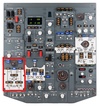
Fuel Control Panel
- Fuel Temperature Gauge - basic rule all 4 pumps working all of the time
- two lights relating to Engine valve and spare valve within the fuel system, two valves that sit in the fuel lines between the engines and the fuel tanks, when on fule is blocked
- Fuel Bypass lights (1 each engine) in the event a filter gets clogged, fue system can skip filter and send direct to engine, ligts up when this happens the crossfeed connects both fue systems to allow fuel flow from both sides of the aircraft
- Fuel Pump switches - 3 fuel tanks, 1 in left wing, 1 in centre & 1 in right wing, each tanks has 2 fuel pumps to send fuel from tanks to engines, better to have fuel in the wing tanks than center, wing taks filled first, low pressure lights will come on when output pressure from pumps is low typically when fuel tanks are low or fault, center tank more powerful so will drain faster


AC/DC Metering Panel
- Display unit showing the different display showig different information relating to the AC and DC power systems, Left DC Amp meter, Center and Right AC Amp meter,
- Problem indicator lights, Battery Disscharge light, Transformer Rectofyer light
- DC and AC Source Selectors moniter the meters
- Battery Master Switch
- Cabin and utility systems switch (Cookers / Water Heaters in Flight Attendent Galleys
- In Flight Entertainment (TV’s and Power suupplies)


Generator Drive and Standby-Power Panel
- Standby Power - indicator light to show when off or a problem
- Left and Right generators, Electrical power is supplied by Generators built into the Engines, when the engines are running they spin a generator and produce electric for the aircraft, lights will come on if their is a problem
- flicking red switches last resort action because they will physically disconect the generators from the engine, which cannot be reveresed


Ground Power and Bus Switching Panel
- Ground Power availability light, if a GPU is connected and suppling power this will light up
- Bus Transfer switch - Bus is a system that switches between two different AC sources, to insure electrical power is not inerupted, responsible for switching between ground power sources, APU Sources, and Engine Generator Sources, lights either side to indicate when off
- Gen 1 and Gen 2 switches - Engines Generators (IDG’s), when the Gen off light is on this means the Generators are ot active and not supplying pwer to the transfer BUS, these are on/off (RED BUS switches are ON/Destroyed)
- In Middle 2 APU Generator switches, APU can supply AC power to the engines
- NOTE: 1) GROUND POWER WHEN PARKED, 2) APU SHORTLY BEFORE DEPARTURE, 3) APU GENERATORS, GROUND POWER IS THEN REMOVED BY GROUND CREW, THEN FINALLY 4) ENGINE GENERATORS BEFORE TURNING OFF THE APU, PROCES IS THEN REVERESED AFTER LANDING


APU Panel and APU Switch
- Blue Maintenence light (if required)
- Warning lights - if problem with APU
- Low oild pressure light, General Fault Light, Overspeed Light
- APU is a mini ject engine that sits in the tail of an aircraft
- APU Gas Temperature Gauge
- APU Switch (not shown here)
- Oil pressure will light - to be expected as long as it doesnt stay on
- Pressure gauge will rise


Left and Right Windscreen
- Allows for various degrees of speed

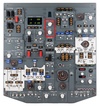
Panel Lights
CIrcuit Breaker & Panel


Equipment cooling Panel
- Controls cooling fans for the Flight Deck Systems
- Like Fans in a computer
- Supply and Exhaust
- Normal and Alternative


Emergency Exit Lights
- Emergency Lighting For Passengers

Bottom Box

Passenger Sign Switches
- Fasten Seat Belt Sign
- Chime Sign (used to be No Smoking - but all planes now Ban smoking)


Attend and Cround Call
Attend - Indicates to Flight Attendents that the Pilot is trying to call them using the intercom System
Ground Call - sounds an alarm in the Wheel well so Ground crew know that the pilot is trying to call someone on the ground
Blue Light - lights up when flight attendent or ground crew member is trying


Window Heat
- For Flight deck windows to prevent iceing
- 4 Windows
- Middle Switch is Stest Switch (Lights)


Probe Heat
- Electronically heat various Ptit tubes, Temperatures probes, and Alpha Vains
- Lights indicate problems

Wing & Engine Anti-Ice
- Wing - Anti-Ice protection is done using hot bleed air which comes from the Engine, air is fed into the Leading edge slats of each wing
- Lights work the same way as Fuel Pumps (blue - moving, open - dim, closed - off_
- Engine - Also uses bleed air from Engine
- Feeds hot air into the engine cow (the front rim of the engine around the main fan)
- Also lights

(Top Only)

Hydrolic Pump Panel (Top Only)
- Hydrolics are important as they drive alot of the moving parts of the aircraft such as ailerons, elevator, flaps, rudder etc
- 2 Hydrolic systems A and B, 2 pumps per system,
- 1 is driven by engine another by an electric motor
- Low pressure lights if problem


Door Annunciator Lights
- Lights up when a door is open


Cockpit voice Recorder Panel
- For Testing the System
- Black button is area mic
- Erase button and headphone jack
- For Maintenence to listen to test sounds and voice recordings


Pressurization Instruments Panel
- LARGE PANEL -
- Larger outer needle indicates the pressure difference between the inside and the outside
- If the difference gets too much (around 9 PSI) then their is a danger of structural damage occuring
- The Inside neeedle shows what altitude the cabin is at so what air pressure is inside the aircraft
- changes to makes sure kept inside the 9 PSI mark
- the instrument below shows the rate at which the cabin altitude is changing (feet per minute)
- Alt horn cut out switch - alarm will sound - pressing this button will cancel the alarm
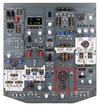

Temperature Gauge and Source selector switch
- By moving the Selector on the right your able to monitor the air temperature in various places of the air conditioning system - Cabin and Pack systems


Trim Air Switch
- Helps regulate the temperature of the air which enters the cabin


Temperature Selectors
- 3 distict zones -
- Cont Cab - Control Cabin (Cockpit)
- Forward Cabin - Front half of the Passenger cabin
- Aft Cabin - Back half of the cabin
- Auto position - on board computers automatically regulate temperatures but pilot can manually set it
- Coldest 18 Degrees C, Hottest 30 Degrees C
- above that are “Zone Temp lights” which light up if air entering the cabin is too hot
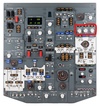

Air Conditioning Unit
- Indicator Lights - Inlet lights
- Recirculation Fans - takes air from the cabin back into the mix manifold t be fed BACK into the cabin, reduces the amount of bleed air needed from the engines, and reduces the amount of work the packs have to do
- Packs - Pressurization Air Conditioning Kits, Packs remove the excessive heat from bleed air entering to packs from aircraft bleed air system and supplies air to the cabin at a desired temperature (They cool the air)
- The Gauge measures the duct pressure,
- The Air enters through an air Ram inlet by the wing
- Isolation Valve - The manifold is normally split by the isolation valve. With the isolation valve switch in AUTO, the isolation valve will only open when an engine bleed air or pack switch is selected OFF
- PACK warning lights / Wing Body Overheat Lights / PACK trip off lights
- Engine bleed Air valve switches
- APU Bleed Air Valve


Cabin Pressurization Panel
- Regulates cabin pressure inside the plane during the flight
- Row of lights -
- Auto Fail Light - if automatic pressurzation system fails this will light
- Off Schedule decsent - lights up if plane decsends before its planned altitude
- Green Lights - When Alternate system is activated or when pilots are manually controlling cabin pressure - can choose auto or manual with this switch
- Flight Altitude Selector - So that the Automatic system can control cabin pressure
- Landing Altitude Selector - (same as above)
- Out-flow-valve - allows air inside the cabin to escape, this helps to regulate air pressure inside the cabin


Rectractible Landing Lights
- Fold out from underneath the aircraft
- Up (Stowed), Extended (fold out but not on), and On

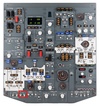
Fixed Landing Lights
- Sit on the Leading Edge of the wing and dont move
- Bar above will turn all on

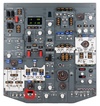
Runway Turnoff Lights
- Point out at an angle next to the fixed landing lights

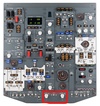
Engine Start Switches
- Engine Igniter Selector - Selects Left, both, or Right ignition systems within an engine
- Engine Start Selectors - 2 - one for each engine, GND will initiate the Engine start procedure


Logo Light
- Lights up the aircrafts tail where an Airline usually have their Logo
*


Position Lights
- Red & Green Wingtip lights
- Down to switch them on as Steady
- middle to turn Off
- Up to ALSO turn on strobes


Anti Collision Lights
- Red Beacon Lights - below and above aircraft
- makes groundcrew aware Engines are running or about to start so stay away


Wing Lights
- Small lights that illuminate the wings
- Allows Pilot and ground crew to inspect the wings in the dark conditions


Wheel Well Lights
- Helps Ground crews examine the wheel wells underneath the aircraft



